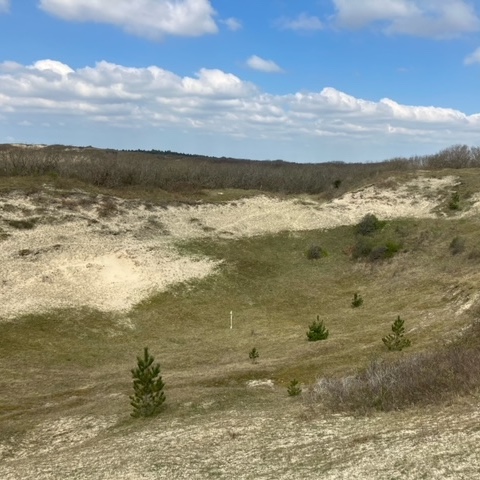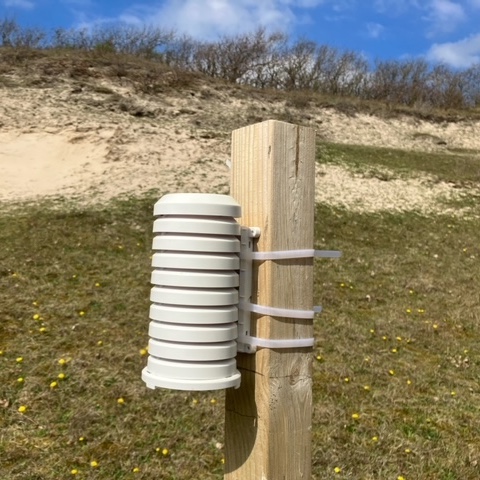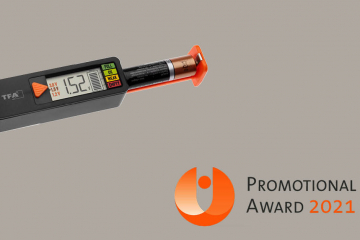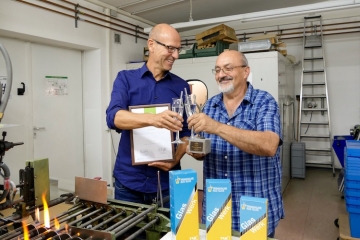Dozens of protective covers have been set up on stakes at a height of 10 cm in deep dune valleys along the Dutch and Belgian coasts. Inside the covers are digital temperature gauges that record the changes in temperature at the bottom of the dune valleys. This research project was initiated by the Flemish and Dutch ‘cold hunters’ Karel Holvoet and Pieter Bliek. Last year, the pair recorded a night frost in the middle of summer in a deep Dutch dune valley, less than 100 meters away from the beach. This turned out to be the coldest on record in the Netherlands.
Protective covers from TFA Dostmann in Dutch and Belgian dune valleys
This research on microclimates is an initiative of the Belgian Karel Holvoet. He started the project more than 10 years ago in sinkholes in the Belgian Ardennes. A sinkhole is a bowl-shaped depression that occurs in limestone landscapes. It is one of the most common forms of sinkhole. “In calm and clear weather, cold air falls into the sinkhole. The air cools much further there than the air outside,” explains the Flemish ‘cold hunter’. Karel developed a fascination for it. In several sinkholes, Karel placed measuring devices to measure changes in temperature. The cold fanatic even travelled to the Alps and Romania, where he recorded record temperatures of up to -51 °C in deep valleys.
Meteorological experiments in deep dune valleys
But because the Alps and Romania are not around the corner from Belgium, the Flemish ‘cold hunter’ looked for alternatives near him.

He conducted some experiments in deep dune valleys that he sought and found on the Dutch coast using an online topography program. In one of these dune valleys, Karel installed a measuring station networked to the Internet.
This enabled the ‘cold hunter’ in Belgium to follow how the temperature was developing in the Dutch dune valley live. Pieter Bliek became involved in the research when he interviewed Karel for a Dutch meteorological magazine.
Network of weather stations
Pieter happens to live on the Dutch coast, a few kilometres away from where Karel set up his weather station in the dune valley. Due to strict Covid measures, the borders were closed at that time. Karel asked Pieter to replace the batteries of his measuring station because he could not come to the Netherlands due to the lockdown. “When I saw and touched the weather station, I also got infected with the ‘cold virus,'” Pieter says. The Fleming and the Dutchman decided to work together from then on. So, the ‘cold hunters’ set up a fine mesh network of weather stations in dune valleys along the Belgian and Dutch coasts. Under ideal weather conditions, the lowest temperatures in the dune valleys can be more than 10 °C lower than the temperatures in the rural surroundings.
Protective covers for digital temperature gauges
In meteorology, air temperatures are usually measured at a height of one-and-a-half meters in an official thermometer shelter. “This is because the temperature gauge’s sensor is protected from direct sunlight and rain, which would otherwise affect the measurements. And if the temperature gauge hangs outside, it emits too much energy so that the measured night-time temperatures indicate a value that is too low,” explains the Dutchman. Because cold air sinks, the temperature has also been measured at a height of 10 centimetres in the Netherlands since the early 1970s.

Dutch record cold temperature…
In more than 30 deep dune valleys along the Dutch and Belgian coasts, there are currently protective covers with digital temperature gauges inside. Every three months, the ‘cold hunters’ visit the dune valleys to read the temperature loggers with their laptop and reset them for another series of measurements. The collected data are analysed and on this basis scientific publications are written about the temperature profile of the microclimates in the Dutch and Belgian dune valleys. Last summer on the morning of 7 August 2022, just before sunrise, the ‘cold hunters’ recorded the Dutch record cold temperature: it froze at -0.46 °C in the deep dune valley of the village of Camperduin – the first time frost was recorded in the Netherlands during the summer months.
…with protective covers from TFA
The record cold temperature was measured using an extremely sensitive sensor at a height of 10 centimetres in a protective cover for outdoor transmitters from the German company TFA Dostmann. “These protective covers are ideal for this kind of scientific research,” Pieter reports. The protective sleeves at the bottom are attached to a small stake in the ground with plastic cable ties. The bottom of the protective cover hangs exactly 10 centimetres above the ground. “When I read the digital temperature loggers periodically, I open the bottom of the protective cover in an instant to take out the data logger. After reading, I put the logger back in the protective case with the same ease. Et voilà!”
The Dutch record cold temperature for the summer was recorded thanks to the initiative of a Flemish ‘cold hunter’ in a Dutch dune valley with the help of a protective cover from TFA Dostmann.

